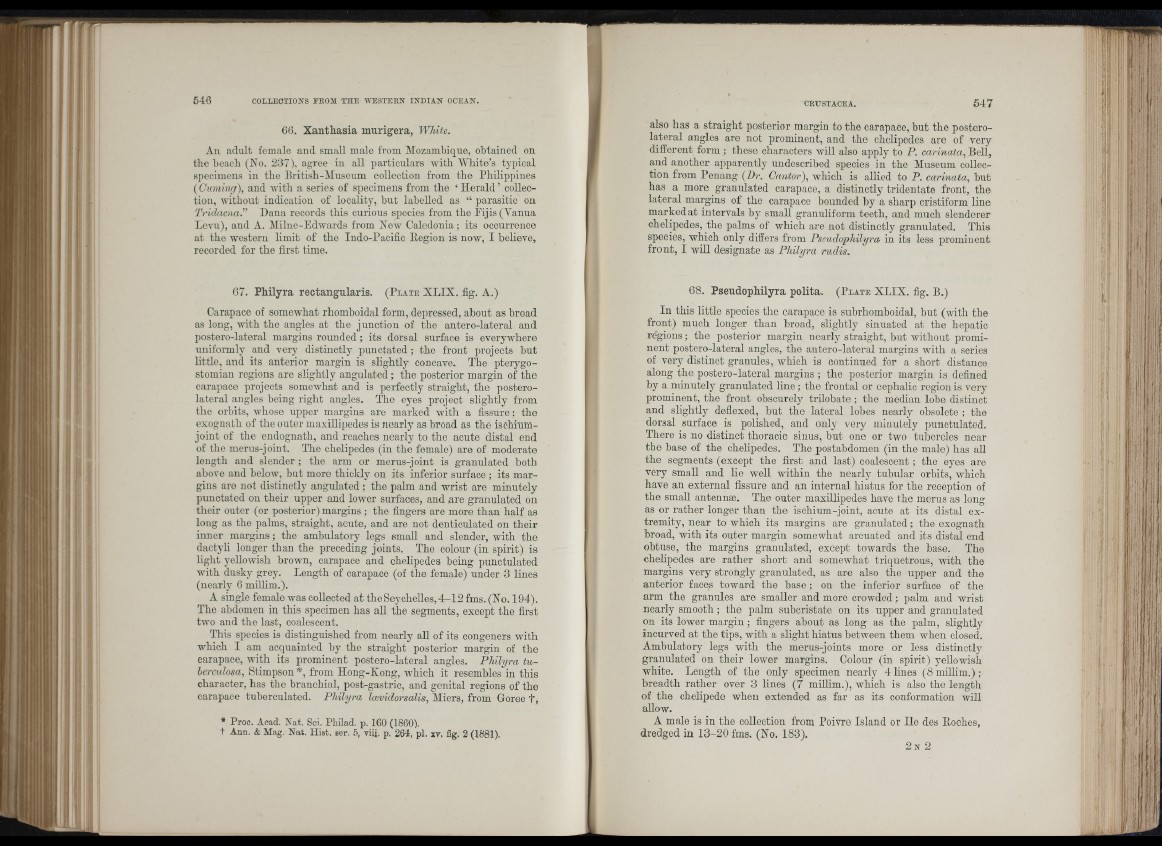
ii
I I
66. Xanthasia murigera, White.
An adult female and small male from Alozamhique, obtained on
the beach (No. 237), agree iu all particulars witb AVhite’s typical
specimens in the British-Museum collection from the Philippines
(Cuming), and with a series of specimens from the ‘H e ra ld ’ collection,
without indication of locality, but labelled as “ parasitic on
Tridacna.” Dana records tbis curious species from the Pijis (Vanua
Levu), and A. Milne-Edivards from New Caledonia; its occurrence
at tbe western limit of tbe Indo-Pacific Begion is now, I believe,
recorded for tbe first time.
67. Philyra rectangularis. (P late XLIX. fig. A.)
Carapace of somewhat rhomboidal form, depressed, about as broad
as long, witb the angles at the junction of the antero-lateral and
postero-lateral margins rounded ; its dorsal surface is everywhere
uniformly and very distinctly punctated ; tbe front projects bnt
little, and its anterior margin is slightly concave. Tbe pterygostomian
regions are slightly angnlated ; tbe posterior margin of the
carapace projects somewhat and is perfectly straight, the posterolateral
angles being right angles. Tbe eyes project slightly from
the orbits, whose upper margins are marked with a fissure ; the
exognath of tbe outer maxiUipedes is nearly as broad as tbe ischmm-
joint of the endognatb, and reaches nearly to the acute distal end
of the merns-joint. Tbe chelipedes (in tbe female) are of moderate
length and slender ; tbe arm or merus-joint is granulated both
above and below, but more thickly on its inferior surface ; its margins
are not distinctly angulated ; tbo palm and wrist are minutely
punctated on tbeir upper and lower surfaces, and nre granulated on
tbeir outer (or posterior) margins ; the fingers are more than half as
long as the palms, straight, acute, and are not denticulated on their
inner margins ; tho ambulatory legs small and slender, with tbo
dactyli longer than the preceding joints. The colour (in spirit) is
light yellowish brown, carapace and chelipedes being punctulated
witb dusky grey. Length of carapace (of the female) under 3 lines
(nearly 6 millim.).
A single female was collected at tbe Seychelles, 4 -1 2 fms. (No. 194).
The abdomen in this specimen has all tbe segments, except tbe first
two and the last, coalescent.
This species is distinguished from nearly aU of its congeners with
wbicb I am acquainted by the straight posterior margin of tbe
carapace, with its prominent postero-lateral angles. Philyra tuberculosa,
Stimpson *, from Hong-Kong, wbicb it resembles in this
character, has the branchial, posBgastric, and genital regions of tbe
carapace tuberculated. Philyra Icevidorscdis, Aliers, from Goree t ,
* Proc. Acad. Nat. Sci. Philad. p. 160 (1860).
t Ann. & Mag. Nat. Hist. ser. 5, viii. p. 264, pi. xv. fig. 2 (1881).
also has a straight posterior margin to tbe carapace, but tbe posterolateral
angles are not prominent, and tbe chelipedes are of very
different fo rm; these characters will also apply to P. carinata. Bell,
and another apparently nndescribed species in tbe Museum collection
from Penang (Dr. Cantor), which is allied to P. carinata, but
has a more granulated carapace, a distinctly tridentate front, tbe
lateral margins of tbe carapace bounded by a sbarp cristiform line
marked at intervals by small granuliform teeth, and much slenderer
chelipedes, the palms of which are not distinctly granulated. This
species, which only differs from Pseudophilyra in its less prominent
front, I wiU designate as Philyra rudis.
68. Pseudophilyra polita. ( P late XLIX. fig. B.)
In tbis little species tbe carapace is snbrhomboidal, but (witb the
front) mucb longer than broad, slightly sinuated at the hepatic
regions ; tbe posterior margin nearly straight, bnt without prominent
postero-lateral angles, tbe antero-lateral margins witb a series
of very distinct granules, which is continued for a short distance
along tbe postero-lateral margius ; the posterior margin is defined
by a minutely granulated line ; tbe frontal or cephalic region is very
prominent, the front obscurely trilobate ; tbe median lobe distinct
and slightly defiexed, but tbe lateral lobes nearly obsolete ; the
dorsal surface is polished, and only very minutely puuctulated.
There is no distinct thoracic sinus, but one or two tubercles near
the base of the chelipedes. The postabdomen (in the male) has all
tbe segments (except the first and last) coalescent ; tbe eyes are
very small and lie well within tbe nearly tnbnlar orbits, which
have an external fissure and an internal hiatus for the reception of
tbe small antennas. Tbe outer maxillipedes have tbe merus as long
as or rather longer than tbe iscbium-joint, acute at its distal extremity,
near to which its margins are granulated ; tbe exognath
broad, witb its outer margin somewhat arcuated and its distal end
obtuse, the margins granulated, except towards the base. Tbe
cbebpedes are rather short and somewhat triquetrous, with tbe
margins very strongly granulated, as are also tbe upper and the
anterior faces toward the base ; on the inferior surface of the
arm the granules are smaller and more crowded ; palm and wrist
nearly smooth ; tbe palm subcristate on its upper and granulated
on its lower margin ; fingers about as long as the palm, slightly
incurved at tbe tips, with a slight hiatus between them wben closed.
Ambulatory legs witb tbe merus-joints more or less distinctlj'-
granulated on their lower margins. Colour (in spirit) yellowish
white. Length of tbe only specimen nearly 4 bnes (8 millim.) ;
breadth ratber over 3 lines (7 millim.), which is also tbe length
of tbe chelipede when extended as far as its conformation will
allow.
A male is in tbe collection from Poivre Island or He des Bocbes,
dredged in 13-20 fms. (No. 183).
.{¿Í
• -i :
Ü-: